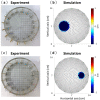Dry Wearable Textile Electrodes for Portable Electrical Impedance Tomography
- PMID: 34696002
- PMCID: PMC8537054
- DOI: 10.3390/s21206789
Dry Wearable Textile Electrodes for Portable Electrical Impedance Tomography
Abstract
Electrical impedance tomography (EIT), a noninvasive and radiation-free medical imaging technique, has been used for continuous real-time regional lung aeration. However, adhesive electrodes could cause discomfort and increase the risk of skin injury during prolonged measurement. Additionally, the conductive gel between the electrodes and skin could evaporate in long-term usage and deteriorate the signal quality. To address these issues, in this work, textile electrodes integrated with a clothing belt are proposed to achieve EIT lung imaging along with a custom portable EIT system. The simulation and experimental results have verified the validity of the proposed portable EIT system. Furthermore, the imaging results of using the proposed textile electrodes were compared with commercial electrocardiogram electrodes to evaluate their performance.
Keywords: EIT; belt; portable electrical impedance tomography; wearable textile electrode.
Conflict of interest statement
The authors declared no potential conflicts of interest with respect to the research, authorship, and/or publication of this article.
Figures













Similar articles
-
Compensation for Electrode Detachment in Electrical Impedance Tomography with Wearable Textile Electrodes.Sensors (Basel). 2022 Dec 7;22(24):9575. doi: 10.3390/s22249575. Sensors (Basel). 2022. PMID: 36559943 Free PMC article.
-
Wearable Electrical Impedance Tomography Belt With Dry Electrodes.IEEE Trans Biomed Eng. 2022 Feb;69(2):955-962. doi: 10.1109/TBME.2021.3110527. Epub 2022 Jan 20. IEEE Trans Biomed Eng. 2022. PMID: 34495826
-
Clinical performance of a novel textile interface for neonatal chest electrical impedance tomography.Physiol Meas. 2018 Apr 26;39(4):044004. doi: 10.1088/1361-6579/aab513. Physiol Meas. 2018. PMID: 29516865
-
Wearable Smart Textiles for Long-Term Electrocardiography Monitoring-A Review.Sensors (Basel). 2021 Jun 17;21(12):4174. doi: 10.3390/s21124174. Sensors (Basel). 2021. PMID: 34204577 Free PMC article. Review.
-
Recent Advances and Challenges in Textile Electrodes for Wearable Biopotential Signal Monitoring: A Comprehensive Review.Biosensors (Basel). 2023 Jun 26;13(7):679. doi: 10.3390/bios13070679. Biosensors (Basel). 2023. PMID: 37504078 Free PMC article. Review.
Cited by
-
Seeing Through Muddy Water: Laser-Induced Graphene for Portable Tomography Imaging.Adv Sci (Weinh). 2024 Sep;11(35):e2406905. doi: 10.1002/advs.202406905. Epub 2024 Jul 15. Adv Sci (Weinh). 2024. PMID: 39007503 Free PMC article.
-
Wearable devices for patient monitoring in the intensive care unit.Intensive Care Med Exp. 2025 Feb 27;13(1):26. doi: 10.1186/s40635-025-00738-8. Intensive Care Med Exp. 2025. PMID: 40016479 Free PMC article. Review.
-
Technical Principles and Clinical Applications of Electrical Impedance Tomography in Pulmonary Monitoring.Sensors (Basel). 2024 Jul 13;24(14):4539. doi: 10.3390/s24144539. Sensors (Basel). 2024. PMID: 39065936 Free PMC article. Review.
-
Compensation for Electrode Detachment in Electrical Impedance Tomography with Wearable Textile Electrodes.Sensors (Basel). 2022 Dec 7;22(24):9575. doi: 10.3390/s22249575. Sensors (Basel). 2022. PMID: 36559943 Free PMC article.
-
Electrical Impedance Tomography: From the Traditional Design to the Novel Frontier of Wearables.Sensors (Basel). 2023 Jan 20;23(3):1182. doi: 10.3390/s23031182. Sensors (Basel). 2023. PMID: 36772222 Free PMC article. Review.
References
-
- Wu Y., Jiang D., Bardill A., De Gelidi S., Bayford R., Demosthenous A. A high frame rate wearable EIT system using ac-tive electrode ASICs for lung respiration and heart rate monitoring. IEEE Trans. Circuits Syst. I Regul. Pap. 2018;65:3810–3820. doi: 10.1109/TCSI.2018.2858148. - DOI
-
- Barber D.C., Brown B.H., Freeston I.L. Imaging spatial distributions of resistivity using applied potential tomog-raphy. Electron. Lett. 1983;19:93–95. doi: 10.1049/el:19830637. - DOI
MeSH terms
LinkOut - more resources
Full Text Sources

